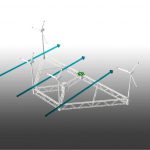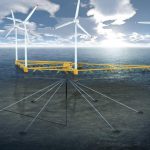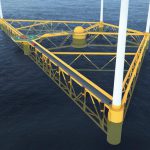The Swedish design and engineering company Hexicon presents a solution for floating wind platforms. The whole platform turns around its center and will always align with the wind direction.
In 2009 the founders of the company came up with the idea to design a multi-turbine wind energy platform[ds_preview] that makes it possible to build wind energy parks on the oceans without having to bother about the depth. So, wind parks may be where there are best winds instead of limiting the park development to shallow waters. According to the European Wind Energy Association the compound annual growth rate (CAGR) for offshore wind is currently around 40%. Also there is an increasing need for reduced visual impact due to the NIMBY effect (Not In My Backyard), driving the wind energy industry further out at sea. The basic idea at Hexicon was to attach the mooring in a central turret and turn the whole platform, so that the wind always comes from one direction. The founders have shipbuilding background.
Today, Hexicon is based in Stockholm and designs, engineers and optimizes the concept of floating wind energy parks. Also considerable effort is put to marketing and lobby for floating energy solutions. In its early stages companies that are establishing floating technologies have to do a lot of pioneering work in order to convince authorities and customers.
A main design principal at Hexicon is to use competence and components that already exist and are well proven in harsh sea environment. Floating platforms for oil & gas production have been in operation for almost 30 years. More than 160 floating platforms are today in operation worldwide. Electrical installations are also well proven in offshore environment. The steel structure, mooring systems, turrets, thrusters, winch systems, power back-up and control systems are all well proven components in the platform. However the combination of these components is new.
Design principles
There are a few initiatives to build floating platforms for wind turbines around the world. But the concept to have several turbines per platform is new. This is the way to gain scale of economy in all aspects, the developers believe. Hexicon has evaluated several conceptual designs and calculated revenues, CAPEX, OPEX, depreciations and LCOE (Levelized Cost of Energy). This work has resulted in different designs but with recurring design principles. The platform is semi-submersible. It is configured to pick-up a minimum amount of energy from the waves in order to be as stable as possible.
There are many advantages with Hexicon’s platforms compared to traditional bottom mounted wind turbines, e.g. large scale deployment far offshore and less amount of individual site engineering in a park. Also main components will be installed in shipyards or quayside, there is less offshore installation and operation compared to traditional parks, all turbines benefit from free wind and the mooring system is well proven. Further, only one power cable per platform reduces the amount of array cabling, platform depth is between 40m to 1000m, sea bed conditions are not critical, the environmental footprint is small, the platform can be relocated and can be renovated in port.
The latest design is a rectangular platform optimized for construction in dry-docks or on quayside, and designed for easy towing transportation. Hexicon identified some 30+ drydocks worldwide large enough to build this platform. The platform turning capability is made possible by a winch system, combined with the standard yawing system of the wind turbines, to cover 360’ wind directions and still have all turbines in free wind.
Smart operation and maintenance
The whole concept may seem expensive due to the wide design and large amount of steel. This is however compensated by the many features for operation and maintenance that the platform can be delivered with. The platform can be equipped with quayside, helipad, work boats, davit crane, self-hoist crane, accommodation and workshops. Some of these optional features can be pooled on one or two platforms in a large park. Also a substation can be placed on board the platform in order to make use of the large structure.
Reference projects in pipeline
Hexicon is currently developing a number of reference projects to be in production within the next five years. The Swedish reference project is a floating platform with 3×6 MW to be located in the southern Baltic sea, in the concession owned by Blekinge Offshore. This project is planned for construction in 2016-2018 and Hexicon has been allocated an area in the concession where the water depth is about 45 m. The Scottish reference project with 3×6 MW is based in northern Scotland. The Scottish Government has a special incentive program for floating wind energy demonstrators. Hexicon is preparing applications for this program. The platform will be designed and sized for the harsh environment of the North Sea. Another project is being planned at the Canary Islands by the island of Gran Canaria, where the water depth is around 250m.
A wind energy platform combined with a desalination plant in the Black Sea has been offered to supply the city of Istanbul with fresh water. This solution could be attractive for islands and nations with water shortage. Producing fresh water with wind energy also solves the problem of storing energy, since freshwater can be stored more easily. Several other markets in Asia, Europe and USA are being pursued, but the lead time to build floating wind energy parks with Hexicon’s platforms may be longer.
The concept is still at the beginning of its product cycle. The platform has to be optimized to produce electricity at a competitive cost and to be ready for different locations. Hexicon also has to convince the stakeholders that the platform performance is as good as in reality as on the drawing board. This is however easier now with the sophisticated aero and hydrodynamical calculation tools that exist today. Some of the technologies that Hexicon are currently evaluating to coexist with wind energy production are wave energy, tidal energy, PV solar cells, desalination and storage of fresh water, oxygenating of damaged sea beds, hydrogen production and storage as well as fish farms.
Author: Mats Arnamo,
Director Marketing & Sales, Hexicon AB,
mats.arnamo@hexicon.eu
Mats Arnamo






















